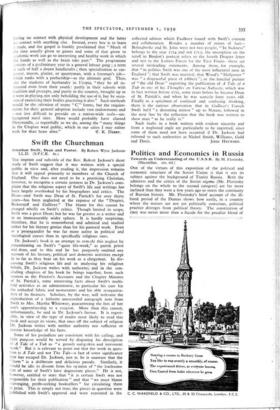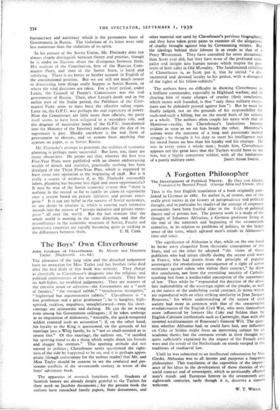Politics and Economics in Russia
Towards an Understanding of the U.S.S.R. By M. Florinsky. (Macmillan. sos. 6d.)
ONE of the virtues of this exposition of the political and economic structure of the Soviet Union is that it sets its subject against the background of Tsarist Russia. Both the admirers and the critics of the Soviet regime (Mr. Florinsky belongs on the whole to the second category) are far more inclined than they were a few years ago to stress the continuity of Russian history. Mr. Florinsky's brief account of the ill- fated period of the Dumas shows how easily, in a country where the masses are not yet politically conscious, political practice diverges from political theory. The constitution of 19o5 was never more than a facade for the peculiar blend of
bureaucracy and autocracy which is the permanent basis of Government in Russia. The violations of its letter were only less numerous than the violations of its spirit.
In his picture of the Soviet Union, Mr. Florinsky does not always clearly distinguish between theory and practice, though he is under no illusions about the divergence between them. His analysis of the Constitution, first of the Russian Com- munist Party, and then of the Soviet State, is lucid and satisfying. There is no better or briefer account in English of the constitutional position. But we are still not much nearer to discovering how things really happen in Soviet Russia, or where the vital decisions are taken. For a brief period, under Lenin, the Council of People's Commissars was the real government of Russia. Then, after Lenin's death and in the earlier part of the Stalin period, the Politburo of the Com- munist Party seem to have been the effective ruling organ. Later on, the G.P.U. was perhaps the real repository of power. Now the Commissars are little more than officials, the party itself seems to have been relegated to a secondary role, and the disgrace of successive heads of the G.P.U. (transformed into the Ministry of the Interior) indicates that the day of its supremacy is past. Hardly anywhere is the real form of government so obscure, and so remote from anything that appears on paper, as in Soviet Russia.
Mr. Florinsky's attempt to penetrate the realities of economic planning is perhaps more successful. But here, too, there are many obscurities. He points out that, whereas the first two Five-Year Plans were published with an almost embarrassing wealth of details and statistics, practically nothing has been divulged of the Third Five-Year Plan, which is supposed to have come into operation at the beginning of 1938. But is it really a source of weakness if, as Mr. Florinsky reasonably infers, planning has become less rigid and more opportunistic? It may be true of the Soviet economic system that " there is nothing in the record so far to justify its claim to superiority over a system based on private initiative and private enter- prise." It is not any belief in the success of Soviet economics, or any desire to emulate it, which is causing such extensive inroads into the system of " private initiative and private enter- prise" all over the world. But the fact remains that the whole world is moving in the same direction, and that the resemblances in the economic structure of Soviet, Fascist and democratic countries are rapidly becoming quite as striking as



































 Previous page
Previous page